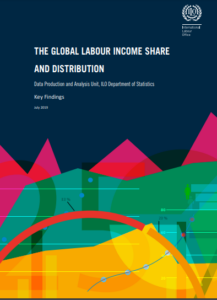Table des matières
Pages connexes
Introduction
Le revenu du travail est le montant que les personnes employées gagnent en travaillant. Les économistes utilisent ce concept pour le distinguer du revenu du capital. Les propriétaires d'actifs gagnent un revenu du capital en raison de leur propriété. Les actifs comprennent les terrains, les machines, les bâtiments ou les brevets. Le revenu du travail comprend le salaire des employés et une partie du revenu des travailleurs indépendants. Les travailleurs indépendants gagnent à la fois leur travail et la propriété du capital.
Pour beaucoup, leur travail est une source essentielle de revenus. En revanche, des études montrent que les revenus du capital profitent de manière disproportionnée aux personnes aisées. Par conséquent, les données sur les revenus du travail peuvent apporter de nouveaux éclairages pour comprendre les inégalités. En outre, des sujets comme l'automatisation, la gig economy ou la mondialisation ont un lien étroit avec les statistiques sur les revenus du travail.
Catalogue de données
| Indicateur | Fréquence | Base de données | Sujet | Téléchargement (avec étiquettes) | Téléchargement (avec codes) | Explorateur de données |
|---|---|---|---|---|---|---|
| Indicateur ODD 10.4.1 - Part du revenu du travail dans le PIB (%) | Annuel | Indicateurs ODD sur le Marché du Travail (ILOSDG) | Revenu du travail | .csv .dta .xlsx | .csv.gz | |
| Part du revenu du travail dans le PIB -- Estimations modélisées du BIT, mai 2025 (%) | Annuel | Estimations Modélisées du BIT (ILOEST) | Revenu du travail | .csv .dta .xlsx | .csv.gz | |
| Répartition du revenu du travail -- Estimations modélisées du BIT, Nov. 2022 (%) | Annuel | Estimations Modélisées du BIT (ILOEST) | Revenu du travail | .csv .dta .xlsx | .csv.gz | |
| Ecart de revenu entre les sexes, rapport entre le revenu du travail des femmes et celui des hommes -- Estimations modélisées du BIT, Mai 2025 (%) | Annuel | Estimations Modélisées du BIT (ILOEST) | Revenu du travail | .csv .dta .xlsx | .csv.gz |
Derniers messages
F.A.Q.
Le revenu du travail est tout montant gagné en travaillant. Les économistes l'utilisent en opposition au revenu du capital, qui est le montant que les propriétaires du capital gagnent grâce à l'utilisation de leur capital. Le capital comprend tout bien utilisé dans la production, comme les terrains, les bâtiments, les machines ou la propriété intellectuelle. Le salaire d'un employé sera enregistré comme un revenu du travail, et son salaire particulier sera classé dans la distribution des revenus du travail. En revanche, tout revenu qui n'est pas obtenu par le travail, mais plutôt par la propriété, sera enregistré comme un revenu du capital et calculé dans la part de revenu du capital.
C'est la première fois que des données internationales complètes sur le revenu du travail et sa distribution sont produites et publiées. Certaines bases de données existantes contiennent des données sur l'inégalité globale des revenus ou l'inégalité de la consommation, mais il n'existait aucune donnée concernant la distribution des revenus du travail. Nous ne savions même pas combien de revenus du travail étaient gagnés dans le monde, et encore moins quelle était leur distribution détaillée pour un grand nombre de pays. Or, de nombreux débats actuels sur les inégalités, comme l'automatisation, le déclin de la classe moyenne ou le salaire minimum, sont très vraisemblablement liés à des facteurs du marché du travail. Mais, jusqu'à présent, nous n'avions pas une image claire de l'aspect revenu du marché du travail.
Nous avons maintenant une image beaucoup plus claire de la répartition des revenus du travail au niveau mondial, et en particulier de la faiblesse des revenus du travail des travailleurs les moins bien rémunérés. Il y a une raison à cela : peu ou pas d'informations étaient disponibles concernant le revenu du travail des indépendants. Pourtant, au niveau mondial, ils représentent près de la moitié de la main-d'œuvre, soit environ 1,5 milliard de travailleurs. Cela a des conséquences importantes sur l'inégalité : dans le monde en développement, les travailleurs indépendants ont tendance à connaître des conditions de travail moins bonnes que les salariés en termes de revenus, de sorte que ne pas les prendre en compte peut être très trompeur.
Mais le problème est plus profond. Dans les pays à faible revenu, les salariés ne représentent qu'un cinquième de la main-d'œuvre, alors que dans les pays à revenu élevé, cette part est proche de 90 %. Avec ces énormes écarts, avant la publication de ce nouvel ensemble de données, toute comparaison internationale approfondie des revenus du travail était impossible. Désormais, nous disposons de données détaillées au niveau des pays et pouvons les comparer directement.
La principale source de données de l'ensemble de données est la collection de microdonnées harmonisées du BIT, qui consiste en des microdonnées d'enquêtes sur le travail. De plus, pour produire une estimation de la part du revenu du travail et de la distribution du revenu du travail, il faut à la fois des microdonnées d'enquête et des données de comptabilité nationale. Dans ce contexte, les données de comptabilité nationale font référence à la fois au produit intérieur brut et à la rémunération des employés dans le référentiel de comptabilité nationale de la Division statistique des Nations Unies (UNSD). Le fait d'exiger des observations au niveau des travailleurs (microdonnées) pour chaque pays et chaque année est assez rigoureux et, naturellement, de nombreuses observations manquent.
Néanmoins, afin de produire des séries chronologiques cohérentes, ainsi que des agrégats mondiaux et régionaux qui ne soient pas biaisés et excessivement volatils - en raison des pays manquants - les observations manquantes doivent être estimées. Bien qu'il existe de multiples modèles statistiques et variables utilisés pour produire des données pour les observations manquantes, deux méthodes principales sont utilisées : l'extrapolation basée sur un modèle et l'imputation. L'extrapolation basée sur un modèle s'appuie sur le fait que pour un pays donné, si au moins une observation de la série possède les données requises, une extrapolation statistique, basée sur ces observations et des variables socio-économiques supplémentaires, donne des résultats qui présentent en général une marge d'erreur relativement faible. L'imputation, en revanche, repose sur une modélisation statistique sur la base de variables socio-économiques pertinentes, mais aucun point de données unique permettant d'ancrer l'estimation pour un pays donné n'est disponible. Par conséquent, la marge d'erreur des observations imputées est considérablement plus importante que celle des observations extrapolées basées sur un modèle. Les observations imputées ne conviennent pas aux comparaisons entre pays, mais elles sont très utiles pour réduire le biais et l'incertitude des estimations mondiales et régionales. C'est la raison pour laquelle elles ont été produites en premier lieu.
L'analyse est effectuée en termes de distribution relative, donc par définition - puisqu'une distribution doit toujours être égale à 100 % - si un groupe particulier enregistre des gains, un autre doit perdre. Mais la question est de savoir qui, dans la distribution, perd et qui gagne lorsque les personnes qui gagnent le plus sont gagnantes. Prenons par exemple l'hypothèse suivante. Il se pourrait que lorsque les 5 % de personnes les mieux rémunérées gagnent, les personnes les moins bien rémunérées finissent également par augmenter leur part, et que seuls les travailleurs ayant des revenus moyens supérieurs perdent. Il s'avère qu'empiriquement, ce que nous avons observé, c'est que lorsque les 5 % les plus riches enregistrent des gains, seuls les revenus les plus élevés augmentent (environ les 10 % les plus élevés). Alors que le reste de la distribution subit des pertes, en particulier dans le cas des travailleurs aux revenus les plus faibles. Par conséquent, les données permettent de tirer la conclusion suivante : les augmentations relatives au sommet ne sont que très étroitement partagées entre les personnes gagnant le plus.
L'analyse est effectuée en termes de distribution relative, donc par définition - puisqu'une distribution doit toujours être égale à 100 % - si un groupe particulier enregistre des gains, un autre doit perdre. Mais la question est de savoir qui, dans la distribution, perd et qui gagne lorsque les salariés médians enregistrent des gains. Prenons par exemple l'hypothèse suivante. Il se pourrait que lorsque les travailleurs médians gagnent, les personnes aux revenus les plus faibles perdent, les personnes aux revenus les plus élevés augmentant leur part. Il s'avère qu'empiriquement, ce que nous avons observé, c'est que lorsque les travailleurs médians connaissent des gains, seuls les revenus les plus élevés connaissent des baisses (environ les 10 % les plus élevés). Alors que le reste de la distribution partage les gains, et en particulier dans le cas des travailleurs les moins rémunérés. Par conséquent, les données indiquent une grande complémentarité dans la distribution des revenus : les augmentations relatives des travailleurs médians sont largement partagées dans toute la distribution, soit environ 80 % des travailleurs. Seuls ceux qui se trouvent au sommet de la distribution finissent par subir des pertes relatives.
Les résultats montrent une association négative en termes relatifs entre les parts supérieures et la plupart des autres parts, en particulier pour les personnes aux revenus les plus faibles. Il n'est pas exclu que l'on puisse améliorer le niveau de vie des personnes les plus modestes en augmentant les revenus les plus élevés, ce qui aurait pour conséquence une croissance économique plus forte. Toutefois, l'effet distributif rend la chose beaucoup plus difficile. En d'autres termes, la croissance économique supplémentaire censée être induite par l'augmentation des revenus les plus élevés devrait être sensiblement plus élevée pour que les plus bas revenus soient mieux lotis qu'en l'absence d'effets distributifs.
La convergence économique a certainement un fort potentiel de réduction des inégalités mondiales, comme le montrent les preuves empiriques concernant les 15 dernières années. Il existe toutefois deux réserves qui méritent d'être mentionnées. Premièrement, pour que la convergence fonctionne, elle doit se produire dans un nombre suffisant de pays (ou dans de grands pays). La Chine, qui a pratiquement atteint la moyenne mondiale, ne sera pas en mesure de faire baisser les inégalités comme elle l'a fait dans le passé. La convergence de l'Inde permet encore de réduire les inégalités. Mais il ne fait aucun doute que si une croissance élevée était maintenue au cours de la prochaine décennie dans les pays à faible revenu, cela contribuerait grandement à la réduction des inégalités mondiales. Deuxièmement, il y a aussi un problème de perspective. Les tendances au niveau national sont sans doute les plus pertinentes pour les travailleurs. Si les travailleurs situés à l'extrémité inférieure de la distribution ont vu leurs salaires réels diminuer ou leur part du gâteau du revenu national se réduire, cela les concernera bien plus que les changements dans l'inégalité mondiale.
Méthodes

Estimations modélisées de l'OIT (base de données ILOEST)
Découvrez les méthodes qui sous-tendent les estimations modélisées de l'OIT sur les statistiques la main-d’œuvre (y compris les travailleurs pauvres), la productivité du travail, la croissance des salaires et la migration de la main-d'œuvre.

La part et la distribution du revenu du travail au niveau mondial : Description méthodologique
L'article est organisé en quatre sections. La section II décrit en détail la méthodologie et sa relation avec la littérature. La section III présente certains des résultats, notamment la part et la distribution du revenu du travail au niveau mondial et leur évolution depuis 2004. La section IV conclut.

Indicateurs de travail décent - Lignes directrices pour les producteurs et les utilisateurs d'indicateurs statistiques et de cadre juridique
Ce manuel présente des lignes directrices sur les indicateurs statistiques du travail décent et les indicateurs du cadre juridique. Il est divisé en onze chapitres qui correspondent aux dix éléments substantiels du travail décent ainsi qu'au contexte économique et social du travail décent.

Sources et méthodes Volume 6 : Statistiques sur les revenus et les dépenses des ménages (2003)
Ce volume présente les descriptions méthodologiques nationales des statistiques sur les revenus et les dépenses des ménages dérivées de diverses sources, principalement d'enquêtes auprès des ménages. Cette information contenant des descriptions pour 98 sources statistiques a été mise à jour en 2003 et constitue la deuxième édition.
Publications
Note : De nombreuses publications ne sont disponibles qu'en anglais. Si elles sont disponibles dans d'autres langues, une nouvelle page s'ouvrira pour afficher ces options.

Perspectives sociales et de l'emploi dans le monde : Mise à jour de septembre 2024
Cette note se concentre sur l'évolution de la relation entre les revenus du travail et du capital, sur les défis auxquels sont confrontés les jeunes sur le marché du travail actuel et sur les progrès accomplis dans la réalisation des principaux objectifs du Millénaire pour le développement à l'approche de l'année 2030.

La part et la répartition des revenus du travail dans le monde : Principales conclusions
La répartition mondiale des revenus du travail est déséquilibrée : un travailleur faisant partie des 10 % les mieux payés gagne 7 445 dollars (PPA) par mois, tandis qu'un travailleur faisant partie des 10 % les moins bien payés ne gagne que 22 dollars.



